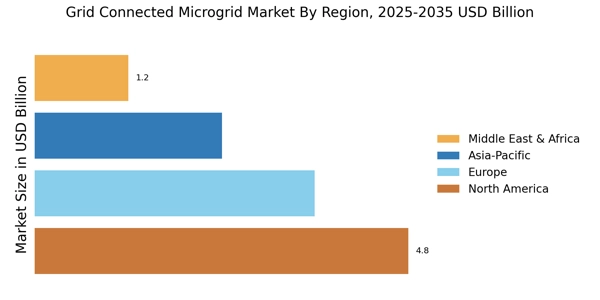Growing Environmental Concerns
Growing environmental concerns are significantly influencing the Grid Connected Microgrid Market. As awareness of climate change and its impacts increases, there is a collective push towards sustainable energy solutions. Microgrids, particularly those powered by renewable energy sources, are viewed as a viable means to reduce carbon footprints and promote environmental stewardship. Recent studies suggest that transitioning to microgrid systems could lead to a reduction in greenhouse gas emissions by up to 40% in certain regions. This environmental imperative is prompting both public and private entities to invest in microgrid technologies, thereby driving growth in the Grid Connected Microgrid Market. The alignment of economic and environmental goals is likely to further enhance the appeal of microgrids in the energy sector.
Supportive Regulatory Frameworks
Supportive regulatory frameworks are playing a crucial role in the expansion of the Grid Connected Microgrid Market. Governments are increasingly recognizing the importance of microgrids in achieving energy transition goals and enhancing grid resilience. Incentives, grants, and favorable policies are being implemented to encourage investment in microgrid technologies. For instance, various regions have established funding programs aimed at supporting the development of renewable energy microgrids. This regulatory backing not only fosters innovation but also attracts private sector participation, thereby accelerating the deployment of microgrid solutions. As a result, the Grid Connected Microgrid Market is likely to see sustained growth driven by these favorable policy environments.
Integration of Smart Technologies
The integration of smart technologies is transforming the Grid Connected Microgrid Market. Advanced communication and control systems enable real-time monitoring and management of energy resources, enhancing operational efficiency. The adoption of Internet of Things (IoT) devices and artificial intelligence (AI) in microgrid systems allows for optimized energy distribution and consumption. This technological evolution not only improves the reliability of energy supply but also facilitates the integration of diverse energy sources, including renewables. As a result, the market is witnessing a shift towards more intelligent and responsive microgrid solutions, which are expected to account for a significant share of the overall energy landscape in the coming years.
Rising Demand for Energy Resilience
The Grid Connected Microgrid Market is experiencing a notable surge in demand for energy resilience. As communities and businesses seek to mitigate the impacts of power outages and disruptions, microgrids offer a reliable solution. This trend is particularly evident in regions prone to extreme weather events, where traditional grid systems may falter. According to recent data, the microgrid market is projected to grow at a compound annual growth rate of over 12% through the next several years. This growth is driven by the increasing recognition of microgrids as a means to enhance energy security and reliability, thereby attracting investments and fostering innovation within the Grid Connected Microgrid Market.
Decentralization of Energy Generation
The trend towards decentralization of energy generation is a key driver in the Grid Connected Microgrid Market. With the rise of distributed energy resources, such as solar panels and wind turbines, communities are increasingly looking to generate their own power. This shift reduces reliance on centralized power plants and enhances local energy independence. Data indicates that decentralized energy systems could account for nearly 30% of total energy generation by 2030. This transition not only empowers consumers but also aligns with sustainability goals, making microgrids an attractive option for municipalities and businesses alike. The Grid Connected Microgrid Market is thus positioned to benefit from this growing preference for localized energy solutions.


















Leave a Comment